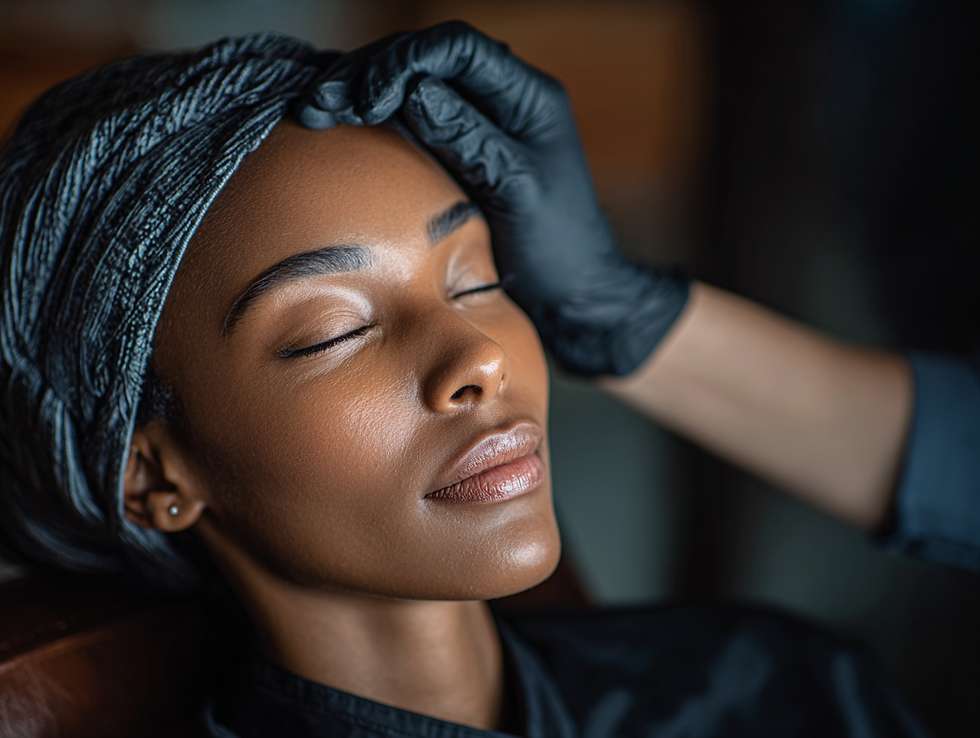Skin Health Signals: What Your Breakouts Are Really Telling You
- Ojus Life
- Jul 31
- 2 min read

Your skin isn’t just a surface to be polished, it’s an active messenger. Breakouts, dryness, and redness are signals from within, offering clues about your hormones, digestion, stress levels, and overall health. Learning to read these skin health signals can help you address root causes instead of covering them up.
Jawline and Chin Breakouts: Hormonal Imbalance
Breakouts along the chin and jawline are often tied to hormonal fluctuations, particularly in androgens like testosterone. These hormones can increase oil production, clog pores, and trigger deeper cystic acne<sup>1</sup>.
Potential internal causes:
Menstrual cycle changes
Polycystic Ovary Syndrome (PCOS)
Coming off or changing birth control
Chronic stress and elevated cortisol
What to do:
Support liver detoxification with leafy greens and fiber
Reduce dairy and refined sugar, both linked to hormonal acne<sup>2</sup>
Consider adaptogens like ashwagandha (consult your healthcare provider)
Forehead Breakouts: Gut and Liver Stress
Acne on the forehead may indicate poor digestion or liver congestion. Alcohol, stress, and nutrient-poor diets can worsen these issues.
Potential internal causes:
Slow digestion or constipation
Gut dysbiosis<sup>2</sup>
Liver strain from medications or alcohol
What to do:
Add probiotics and fermented foods
Drink lemon water in the morning
Eat cruciferous vegetables for liver support
Cheek Breakouts: Respiratory and Environmental Stress
Cheek acne often connects to the lungs and environmental exposure. Irritants like smoke, allergens, or dirty surfaces can trigger inflammation.
Potential internal or external causes:
Smoking or secondhand smoke
Seasonal allergies or sinus congestion
Dirty phone screens or pillowcases
What to do:
Change pillowcases 2–3 times per week
Clean your phone daily
Try lymphatic drainage or facial massage for detox support
Dry, Flaky Skin: Dehydration and Nutrient Deficiency
Rough, tight, or flaky skin may signal dehydration or a lack of healthy fats and micronutrients<sup>3</sup>.
Potential internal causes:
Not drinking enough water
Low omega-3 intake from fish, flax, or chia
Deficiencies in vitamins A, D, and E
What to do:
Increase water and mineral-rich fluids such as coconut water or herbal teas
Supplement with omega-3s if needed<sup>3</sup>
Eat avocado, olive oil, and wild-caught fish regularly
Inflamed or Sensitive Skin: Immune or Stress Response
Redness, reactivity, and inflammation can signal an overstimulated immune system or chronic stress. A weakened skin barrier is often more sensitive to environmental and dietary triggers.
Potential internal causes:
Chronic stress
Food sensitivities such as gluten, dairy, or eggs
Leaky gut or histamine intolerance
What to do:
Consider functional testing for food sensitivities
Practice daily stress-reducing rituals like breathwork or gentle movement
Use calming skincare ingredients such as aloe, oat, or calendula
Treat Skin from the Inside Out
Topical products and in-office treatments like chemical peels, PRP microneedling, or infrared therapy can help. But lasting results come from internal support. When you nurture your body from within, you create the strongest foundation for healthy, radiant skin.
Your skin is a storyteller. Listen closely and give it the holistic care it deserves.
References
Dreno, B., et al. (2018). Understanding the pathophysiology of acne. Journal of the European Academy of Dermatology and Venereology, 32(12), 2036–2045. https://doi.org/10.1111/jdv.15049
Bowe, W. P., & Logan, A. C. (2010). Acne vulgaris, probiotics and the gut–brain–skin axis. Gut Pathogens, 3(1), 1. https://doi.org/10.1186/1757-4749-3-1
Yoon, J. Y., et al. (2015). Effects of omega-3 fatty acids on inflammatory acne. Acta Dermato-Venereologica, 95(6), 703–710. https://doi.org/10.2340/00015555-2061




